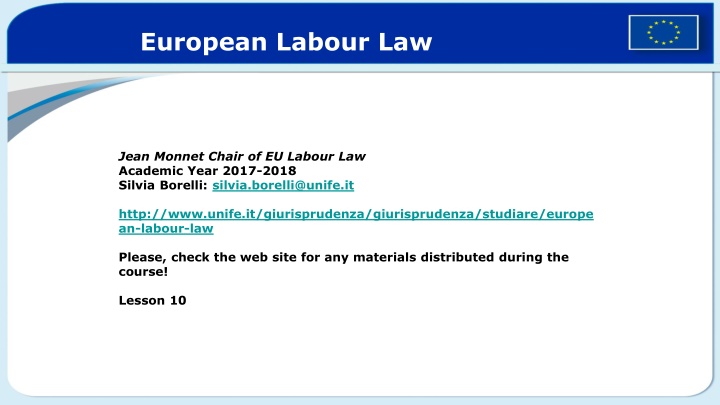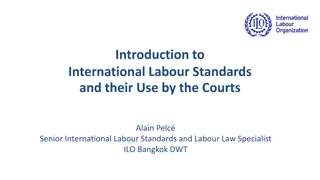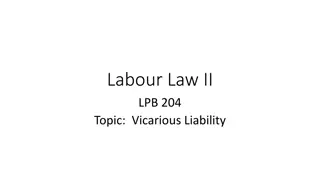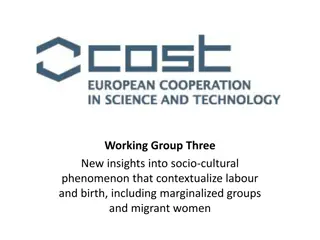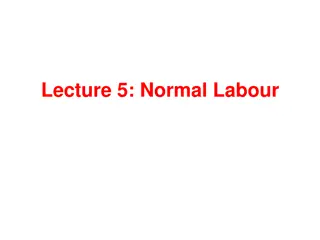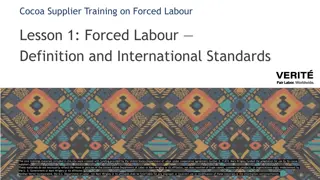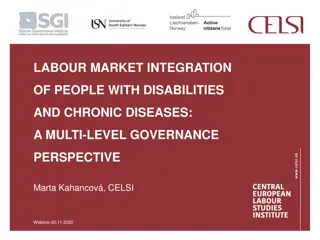European Labour Law and Health & Safety Regulations Overview
European Labour Law covers health and safety regulations for workers, with directives focusing on safety signs, occupational exposure limits, and general workplace safety. The Framework Directive sets obligations for employers and employees to prevent accidents and diseases, emphasizing risk assessment and employer responsibility. The aim is to establish a uniform level of safety across all sectors while allowing member states to adopt stricter rules.
Download Presentation

Please find below an Image/Link to download the presentation.
The content on the website is provided AS IS for your information and personal use only. It may not be sold, licensed, or shared on other websites without obtaining consent from the author.If you encounter any issues during the download, it is possible that the publisher has removed the file from their server.
You are allowed to download the files provided on this website for personal or commercial use, subject to the condition that they are used lawfully. All files are the property of their respective owners.
The content on the website is provided AS IS for your information and personal use only. It may not be sold, licensed, or shared on other websites without obtaining consent from the author.
E N D
Presentation Transcript
European Labour Law Jean Monnet Chair of EU Labour Law Academic Year 2017-2018 Silvia Borelli: silvia.borelli@unife.it http://www.unife.it/giurisprudenza/giurisprudenza/studiare/europe an-labour-law Please, check the web site for any materials distributed during the course! Lesson 10
Health and safety at work The first European directives on safety and health at work (e.g. Directive 77/576/ EEC on the harmonisation of national laws on safety signs in the workplace and Directive 78/610/ EEC on the harmonisation of occupational exposure limits to vinyl chloride monomers were adopted on this basis) were adopted on the basis of the general market harmonisation provisions. This was due to a lack of an explicit legislative competence in the Treaty in the field of safety and health at work until the mid-1980s. The Single European Act 1987 introduced a new legal provision on social policy to the Treaty aiming for improvements, especially in the working environment, as regards the health and safety of workers (Art. 118A). Article 153 of the Treaty on the Functioning of the European Union gives the EU the authority to adopt directives in the field of safety and health at work. The Framework Directive (Council Directive 89/391/EEC of 12 June 1989 on the introduction of measures to encourage improvements in the safety and health of workers at work) and further directives focusing on specific aspects of safety and health at work are the fundamentals of European safety and health legislation. Member States are free to adopt stricter rules for the protection of workers when transposing EU directives into national law.
Health and safety at work The Framework Directive lays down general principles concerning the prevention and protection of workers against occupational accidents and diseases. It sets out obligations for both employers and employees to reduce accidents and occupational disease in the workplace. Nevertheless, the workers' obligations shall not affect the principle of the responsibility of the employer. It is the employer's obligation to ensure the safety and health of workers in every aspect related to work and he may not impose financial costs to the workers to achieve this aim. Alike, where an employer enlists competent external services or persons, this shall not discharge him from his responsibilities in this area. The Directive obliges employers to take appropriate preventive measures to make work safer and healthier. The Directive introduces the principle of risk assessment and defines its main elements (e.g. hazard identification, worker participation, introduction of adequate measures with the priority of eliminating risk at source, documentation and periodical re-assessment of workplace hazards). The Framework Directive applies to all sectors of activity, both public and private, except for specific public service activities, such as the armed forces, the police or certain civil protection services. The Directive aims to establish an equal level of safety and health for the benefit of all workers (the only exceptions are domestic workers and certain public and military services).
Health and safety at work The Framework Directive stipulates that employers: evaluate all the risks to the safety and health of workers implement measures which assure an improvement in the level of protection afforded to workers and are integrated into all the activities of the undertaking and/or establishment at all hierarchical levels ensure that each worker receives adequate safety and health training appoint someone responsible for the prevention of risks at work provide employees and/or their representatives with all relevant information on possible health and safety risks and the measures taken to prevent them consult employees and/or their representatives and involve them in all discussions on health and safety at work.
Health and safety at work Each employee is responsible for taking care, as far as possible, of their own, and their colleagues , health and safety. The worker shall: make correct use of machinery, apparatus, tools, dangerous substances, transport equipment, other means of production and personal protective equipment immediately inform the employer of any work situation presenting a serious and immediate danger and of any shortcomings in the protection arrangements cooperate with the employer in fulfilling any requirements imposed for the protection of health and safety and in enabling him to ensure that the working environment and working conditions are safe and pose no risks. Special protection must be given to employees who may be particularly sensitive to possible risks and dangers in the workplace.
Health and safety at work On the basis of the "Framework Directive" a series of individual directives were adopted. The Framework Directive continues to apply to all the areas covered by the individual directives, but where individual directives contain more stringent and/or specific provisions, these special provisions of individual directives prevail. The individual directives focus on specific aspects of safety and health at work. Individual directives tailor the principles of the Framework Directive to: Specific tasks (e.g. manual handling of loads) Specific hazards at work (e.g. exposure to dangerous substances) Specific workplaces and sectors (e.g. temporary work sites, extractive industries, fishing vessels) Specific groups of workers (e.g. pregnant women, young workers, workers with a fixed duration employment contract) Certain work-related aspects (e.g. organisation of working time).
EU Occupational Safety and Health (OSH) Strategic Framework 2014-2020 The European Commission has adopted a new Strategic Framework on Health and Safety at Work 2014-2020, which identifies key challenges and strategic objectives for health and safety at work, presents key actions and identifies instruments to address these. The Strategic Framework identifies three major health and safety at work challenges: to improve implementation of existing health and safety rules, in particular by enhancing the capacity of micro and small enterprises to put in place effective and efficient risk prevention strategies to improve the prevention of work-related diseases by tackling new and emerging risks without neglecting existing risks to take account of the ageing of the EU's workforce.
EU Occupational Safety and Health (OSH) Strategic Framework 2014-2020 The Strategic Framework proposes to address these challenges with a range of actions under seven key strategic objectives: Further consolidating national health and safety strategies through, for example, policy coordination and mutual learning. Providing practical support to small and micro enterprises to help them to better comply with health and safety rules. Businesses would benefit from technical assistance and practical tools, such as the Online Interactive Risk Assessment (OiRA), a web platform providing sectoral risk assessment tools. Improving enforcement by Member States for example by evaluating the performance of national labour inspectorates. Simplifying existing legislation where appropriate to eliminate unnecessary administrative burdens, while preserving a high level of protection for workers health and safety. Addressing the ageing of the European workforce and improving prevention of work-related diseases to tackle existing and new risks such as nanomaterials, green technology and biotechnologies. Improving statistical data collection to have better evidence and developing monitoring tools. Reinforcing coordination with international organisations (such as the International Labour Organisation (ILO), the World Health Organisation (WHO) and the Organisation for Economic Co-operation and Development (OECD) and partners to contribute to reducing work accidents and occupational diseases and to improving working conditions worldwide.
European Agency for Health and Safety at Work (EU-OSHA) The Healthy Workplaces Campaigns to raise awareness of occupational safety and health (OSH) topics across Europe Online interactive Risk Assessment (OiRA) tools for small and medium-sized enterprises to assess and manage risks in the workplace The ESENER survey to provide a snapshot of how safety and health risks are managed in European workplaces OSHwiki a collaborative online encyclopedia of accurate and reliable information on OSH Foresight projects to highlight and study new and emerging risks in OSH OSH overviews on specific OSH topics NAPO films a series of short, lighthearted, language-free films on important workplace safety and health topics Committees of national experts contribute to developing, implementing and monitoring EU legislation on health and safety at work Advisory Committee on Safety and Health at Work (ACSH) Scientific Committee on Occupational Exposure Limits (SCOEL) Senior Labour Inspectors Committee (SLIC)
